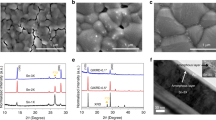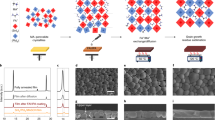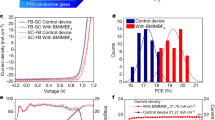Abstract
Low bandgap tin–lead iodide perovskites are key components of all-perovskite tandem solar cells, but can be unstable because tin is prone to oxidation. Here, to avoid a reaction with the most popular hole contact, we eliminated polyethylenedioxythiophene:polystyrenesulfonate as a hole transport layer and instead used an upward band offset at an indium tin oxide–perovskite heterojunction to extract holes. To suppress oxidative degradation, we improved the morphology to create a compact and large-grained film. The tin content was kept at or below 50% and the device capped with a sputtered indium zinc oxide electrode. These advances resulted in a substantially improved thermal and environmental stability in a low bandgap perovskite solar cell without compromising the efficiency. The solar cells retained 95% of their initial efficiency after 1,000 h at 85 °C in air in the dark with no encapsulation and in a damp heat test (85 °C with 85% relative humidity) with encapsulation. The full initial efficiency was maintained under operation near the maximum power point and near 1 sun illumination for over 1,000 h.
This is a preview of subscription content, access via your institution
Access options
Access Nature and 54 other Nature Portfolio journals
Get Nature+, our best-value online-access subscription
$29.99 / 30 days
cancel any time
Subscribe to this journal
Receive 12 digital issues and online access to articles
$119.00 per year
only $9.92 per issue
Buy this article
- Purchase on Springer Link
- Instant access to full article PDF
Prices may be subject to local taxes which are calculated during checkout




Similar content being viewed by others
Data availability
The data that support the plots within this article and other findings of this study are available from the corresponding author upon reasonable request.
References
Leijtens, T., Bush, K. A., Prasanna, R. & McGehee, M. D. Opportunities and challenges for tandem solar cells using metal halide perovskite semiconductors. Nat. Energy 3, 828–838 (2018).
Hörantner, M. T. et al. The potential of multijunction perovskite solar cells. ACS Energy Lett. 2, 2506–2513 (2017).
Eperon, G. E. et al. Perovskite–perovskite tandem photovoltaics with optimized band gaps. Science 354, 861–865 (2016).
Palmstrom, A. F. et al. Enabling flexible all-perovskite tandem solar cells. Joule 3, 2193–2204 (2019).
Rajagopal, A., Liang, P.-W., Chueh, C.-C., Yang, Z. & Jen, A. K.-Y. Passivation via graded fullerene heterojunction in low bandgap Pb–Sn binary perovskite photovoltaics. ACS Energy Lett. 2, 2531–2539 (2017).
Leijtens, T. et al. Tin–lead halide perovskites with improved thermal and air stability for efficient all-perovskite tandem solar cells. Sustain. Energy Fuels 2, 2450–2459 (2018).
Forgács, D. et al. Efficient monolithic perovskite/perovskite tandem solar cells. Adv. Energy Mater. 8, 1602121 (2016).
Zhao, D. et al. Efficient two-terminal all-perovskite tandem solar cells enabled by high-quality low-bandgap absorber layers. Nat. Energy 3, 1093–1100 (2018).
Eperon, G. E., Hörantner, M. T. & Snaith, H. J. Metal halide perovskite tandem and multiple-junction photovoltaics. Nat. Rev. Chem. 1, 0095 (2017).
Hao, F., Stoumpos, C. C., Chang, R. P. H. & Kanatzidis, M. G. Anomalous band gap behavior in mixed Sn and Pb perovskites enables broadening of absorption spectrum in solar cells. J. Am. Chem. Soc. 136, 8094–8099 (2014).
Prasanna, R. et al. Band gap tuning via lattice contraction and octahedral tilting in perovskite materials for photovoltaics. J. Am. Chem. Soc. 139, 11117–11124 (2017).
Noel, N. K. et al. Lead-free organic–inorganic tin halide perovskites for photovoltaic applications. Energy Environ. Sci. 7, 3061–3068 (2014).
Takahashi, Y. et al. Charge-transport in tin iodide perovskite CH3NH3SnI3: origin of high conductivity. Dalton Trans. 40, 5563 (2011).
Boyd, C. C., Cheacharoen, R., Leijtens, T. & McGehee, M. D. Understanding degradation mechanisms and improving stability of perovskite photovoltaics. Chem. Rev. 119, 3418–3451 (2019).
Grancini, G. et al. One-year stable perovskite solar cells by 2D/3D interface engineering. Nat. Commun. 8, 15684 (2017).
Christians, J. A. et al. Tailored interfaces of unencapsulated perovskite solar cells for >1,000 hour operational stability. Nat. Energy 3, 68–74 (2018).
Cheacharoen, R. et al. Encapsulating perovskite solar cells to withstand damp heat and thermal cycling. Sustain. Energy Fuels 2, 2398–2406 (2018).
Wang, Z. et al. Efficient and ambient-air-stable solar cells with 2D–3D hetero-structured butylammonium–caesium–formamidinium lead halide perovskites. Nat. Energy 2, 17135– (2017).
Hou, Y. et al. A generic interface to reduce the efficiency–stability–cost gap of perovskite solar cells. Science 358, 1192–1197 (2017).
Marshall, K. P., Walker, M., Walton, R. I. & Hatton, R. A. Enhanced stability and efficiency in hole-transport-layer-free CsSnI3 perovskite photovoltaics. Nat. Energy 1, 1–14 (2016).
Gao, W. et al. Robust stability of efficient lead-free formamidinium tin iodide perovskite solar cells realized by structural regulation. J. Phys. Chem. Lett. 9, 6999–7006 (2018).
Leijtens, T., Prasanna, R., Gold-Parker, A., Toney, M. F. & McGehee, M. D. Mechanism of tin oxidation and stabilization by lead substitution in tin halide Perovskites. ACS Energy Lett. 2, 2159–2165 (2017).
Liao, Y. et al. Highly oriented low-dimensional tin halide perovskites with enhanced stability and photovoltaic performance. J. Am. Chem. Soc. 139, 6693–6699 (2017).
Liu, C. et al. C60 additive-assisted crystallization in CH3NH3Pb0.75Sn0.25I3 perovskite solar cells with high stability and efficiency. Nanoscale 9, 13967–13975 (2017).
Chi, D. et al. Composition and interface engineering for efficient and thermally stable Pb–Sn mixed low-bandgap perovskite solar cells. Adv. Funct. Mater. 28, 1804603 (2018).
Chen, Z. et al. Stable Sn/Pb-based perovskite solar cells with a coherent 2D/3D interface. iScience 9, 337–346 (2018).
Holzhey, P. & Saliba, M. A full overview of international standards assessing the long-term stability of perovskite solar cells. J. Mater. Chem. A 6, 21794–21808 (2018).
McMeekin, D. P. et al. A mixed-cation lead mixed-halide perovskite absorber for tandem solar cells. Science 351, 151–155 (2016).
Turren-Cruz, S. H., Hagfeldt, A. & Saliba, M. Methylammonium-free, high-performance, and stable perovskite solar cells on a planar architecture. Science 362, 449–453 (2018).
Tan, W., Bowring, A. R., Meng, A. C., McGehee, M. D. & McIntyre, P. C. Thermal stability of mixed cation metal halide perovskites in air. ACS Appl. Mater. Interfaces 10, 5485–5491 (2018).
Bush, K. A. et al. Thermal and environmental stability of semi‐transparent perovskite solar cells for tandems enabled by a solution‐processed nanoparticle buffer layer and sputtered ITO electrode. Adv. Mater. 28, 3937–3943 (2016).
Kraut, E. A., Grant, R. W., Waldrop, J. R. & Kowalczyk, S. P. Precise determination of the valence-band edge in X-ray photoemission spectra: application to measurement of semiconductor interface potentials. Phys. Rev. Lett. 44, 1620–1623 (1980).
Boyd, C. C. et al. Barrier design to prevent metal-induced degradation and improve thermal stability in perovskite solar cells. ACS Energy Lett. 3, 1772–1778 (2018).
Zhao, D. et al. Low-bandgap mixed tin–lead iodide perovskite absorbers with long carrier lifetimes for all-perovskite tandem solar cells. Nat. Energy 2, 17018 (2017).
Xiao, Z. et al. Mixed-halide perovskites with stabilized bandgaps. Nano Lett 17, 6863–6869 (2017).
Li, W. et al. Subgrain special boundaries in halide perovskite thin films restrict carrier diffusion. ACS Energy Lett. 3, 2669–2670 (2018).
Kim, G. Y. et al. Large tunable photoeffect on ion conduction in halide perovskites and implications for photodecomposition. Nat. Mater. 17, 445–449 (2018).
Milot, R. L. et al. The effects of doping density and temperature on the optoelectronic properties of formamidinium tin triiodide thin films. Adv. Mater. 30, e1804506 (2018).
Domanski, K. et al. Not all that glitters is gold: metal-migration-induced degradation in perovskite solar cells. ACS Nano 10, 6306–6314 (2016).
Bush, K. A. et al. 23.6%-efficient monolithic perovskite/silicon tandem solar cells with improved stability. Nat. Energy 2, 17009 (2017).
Perkins, C. L. & Hasoon, F. S. Surfactant-assisted growth of CdS thin films for photovoltaic applications. J. Vac. Sci. Technol. A 24, 497–504 (2006).
Acknowledgements
This research was supported by the Office of Naval Research award N00014-17-1-2212 and by the US Department of Energy’s Office of Energy Efficiency and Renewable Energy (EERE) under Solar Energy Technologies Office (SETO) agreement no. DE-EE0008551. Work at the Stanford Nano Shared Facilities (SNSF) was supported by the National Science Foundation award ECCS-1542152. S.P.D., M.F.A.M.v.H. and G.T. were supported by the US Department of Energy contract no. DE-AC36-08GO28308 with the Alliance for Sustainable Energy LLC, Manager and Operator of the National Renewable Energy Laboratory (NREL). The authors acknowledge support from the De-risking Halide Perovskite Solar Cells and Combined Characterization projects at NREL, funded by the US Department of Energy, Office of Energy Efficiency and Renewable Energy, Solar Energy Technologies Office. J.J.B. was supported by the Office of Naval Research. We thank S. U. Nanayakkara for performing the atomic force microscopy measurements.
Author information
Authors and Affiliations
Contributions
R.P. and T.L., under the supervision of M.D.M., designed the study. R.P. and T.L. designed the experiments, fabricated solar cells and conducted and interpreted various characterization. S.P.D. and G.T. conducted and interpreted all the XPS measurements. S.P.D., E.J.W., T.L., R.P., J.A.R., G.E.E., S.A.S., J.W., M.F.A.M.v.H., A.F.P. and C.C.B. fabricated devices and/or conducted various stability tests. C.d.P. performed the SEM characterization. R.P. wrote the first draft of the paper. M.D.M., J.J.B. and S.F.B. supervised the work. All the authors contributed to the analysis of the results and revision of the paper.
Corresponding author
Ethics declarations
Competing interests
T.L. and G.E.E. are co-founders of, and M.D.M. is an advisor to, Swift Solar Inc., a company commercializing perovskite solar cells. All other authors declare no competing interests.
Additional information
Publisher’s note Springer Nature remains neutral with regard to jurisdictional claims in published maps and institutional affiliations.
Supplementary information
Supplementary Information
Supplementary Figs. 1–14, Note 1, Table 1 and ref. 1.
Rights and permissions
About this article
Cite this article
Prasanna, R., Leijtens, T., Dunfield, S.P. et al. Design of low bandgap tin–lead halide perovskite solar cells to achieve thermal, atmospheric and operational stability. Nat Energy 4, 939–947 (2019). https://doi.org/10.1038/s41560-019-0471-6
Received:
Accepted:
Published:
Issue Date:
DOI: https://doi.org/10.1038/s41560-019-0471-6
This article is cited by
-
Perovskite–organic tandem solar cells
Nature Reviews Materials (2024)
-
Mixed tin-lead perovskites with balanced crystallization and oxidation barrier for all-perovskite tandem solar cells
Nature Communications (2024)
-
Inverted perovskite solar cells using dimethylacridine-based dopants
Nature (2023)
-
Oxidation-resistant all-perovskite tandem solar cells in substrate configuration
Nature Communications (2023)
-
Heterojunction formed via 3D-to-2D perovskite conversion for photostable wide-bandgap perovskite solar cells
Nature Communications (2023)



